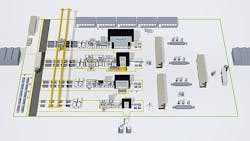Schuler AG recently unveiled a Machine Monitoring System (MMS) for forming operations that it declared “provides completely new insights into presses”: system monitoring can increase availability, improved process and part quality, and reduced energy consumption. The MMS is part of the Schuler Smart Press Shop collection of networked process control technologies for forming technology.
The monitoring system combines several established technology “solutions,” beginning with intelligent diagnostics that automatically archive and evaluate physical variables and control states when specific events occur. This promotes rapid fault analysis.
The state monitoring function monitors the system at regular intervals for damage and wear, using torque curves and structure-borne noise analyses, for example. Thanks to this state-based maintenance, components only need to be replaced when they have actually reached the end of their life, and not just because they have been in operation for a specific amount of time.
For process monitoring, the focus is on machine protection. Permanent logging of parameters such as press force or vibration progression allow a cycle-accurate response in real time, where necessary. Process reliability is thereby also improved.
Energy monitoring involves recording and evaluating all measured variables that are relevant for energy efficiency and network quality, such as power consumption, voltage dips, or harmonics. This means that not only can system operators save energy costs, in some circumstances they also can obtain investment subsidies or more favorable loan terms.
The production data acquired includes all planned and unplanned downtime, including causes, fault messages, target/actual production and the quality of the parts. In this way, the system operators gain an overview of the production status and a basis for calculating the overall equipment efficiency (OEE).
Last, all quality-relevant data is recorded and archived for each part produced. This assists the manufacturer to provide the necessary proof for items such as safety parts.
Learn more at www.schulergroup.com
